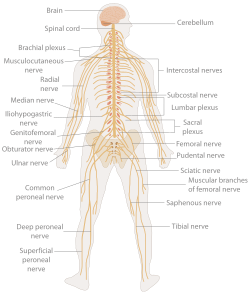
Back Senuweestelsel Afrikaans Nervensystem ALS Sistema niervoso AN جهاز عصبي Arabic سيستيم عصبي ARY جهاز عصبى ARZ স্নায়ু তন্ত্ৰ Assamese Sistema nerviosu AST Sinir sistemi Azerbaijani عصب سیستمی AZB
| Nervous system | |
|---|---|
 The human nervous system | |
| Details | |
| Identifiers | |
| Latin | systema nervosum |
| MeSH | D009420 |
| TA98 | A14.0.00.000 |
| FMA | 7157 |
| Anatomical terminology | |
In biology, the nervous system is the highly complex part of an animal that coordinates its actions and sensory information by transmitting signals to and from different parts of its body. The nervous system detects environmental changes that impact the body, then works in tandem with the endocrine system to respond to such events.[1] Nervous tissue first arose in wormlike organisms about 550 to 600 million years ago. In vertebrates, it consists of two main parts, the central nervous system (CNS) and the peripheral nervous system (PNS). The CNS consists of the brain and spinal cord. The PNS consists mainly of nerves, which are enclosed bundles of the long fibers, or axons, that connect the CNS to every other part of the body. Nerves that transmit signals from the brain are called motor nerves (efferent), while those nerves that transmit information from the body to the CNS are called sensory nerves (afferent). The PNS is divided into two separate subsystems, the somatic and autonomic, nervous systems. The autonomic nervous system is further subdivided into the sympathetic, parasympathetic and enteric nervous systems. The sympathetic nervous system is activated in cases of emergencies to mobilize energy, while the parasympathetic nervous system is activated when organisms are in a relaxed state. The enteric nervous system functions to control the gastrointestinal system. Nerves that exit from the brain are called cranial nerves while those exiting from the spinal cord are called spinal nerves.
The nervous system consists of nervous tissue which, at a cellular level, is defined by the presence of a special type of cell, called the neuron. Neurons have special structures that allow them to send signals rapidly and precisely to other cells. They send these signals in the form of electrochemical impulses traveling along thin fibers called axons, which can be directly transmitted to neighboring cells through electrical synapses or cause chemicals called neurotransmitters to be released at chemical synapses. A cell that receives a synaptic signal from a neuron may be excited, inhibited, or otherwise modulated. The connections between neurons can form neural pathways, neural circuits, and larger networks that generate an organism's perception of the world and determine its behavior. Along with neurons, the nervous system contains other specialized cells called glial cells (or simply glia), which provide structural and metabolic support. Many of the cells and vasculature channels within the nervous system make up the neurovascular unit, which regulates cerebral blood flow in order to rapidly satisfy the high energy demands of activated neurons.[2]
Nervous systems are found in most multicellular animals, but vary greatly in complexity.[3] The only multicellular animals that have no nervous system at all are sponges, placozoans, and mesozoans, which have very simple body plans. The nervous systems of the radially symmetric organisms ctenophores (comb jellies) and cnidarians (which include anemones, hydras, corals and jellyfish) consist of a diffuse nerve net. All other animal species, with the exception of a few types of worm, have a nervous system containing a brain, a central cord (or two cords running in parallel), and nerves radiating from the brain and central cord. The size of the nervous system ranges from a few hundred cells in the simplest worms, to around 300 billion cells in African elephants.[4]
The central nervous system functions to send signals from one cell to others, or from one part of the body to others and to receive feedback. Malfunction of the nervous system can occur as a result of genetic defects, physical damage due to trauma or toxicity, infection, or simply senescence. The medical specialty of neurology studies disorders of the nervous system and looks for interventions that can prevent or treat them. In the peripheral nervous system, the most common problem is the failure of nerve conduction, which can be due to different causes including diabetic neuropathy and demyelinating disorders such as multiple sclerosis and amyotrophic lateral sclerosis. Neuroscience is the field of science that focuses on the study of the nervous system.
- ^ Tortora, G.J.; Derrickson, B. (2016). Principles of Anatomy and Physiology (15th ed.). J. Wiley. ISBN 978-1-119-34373-8.
- ^ Iadecola, Costantino (27 September 2017). "The Neurovascular Unit Coming of Age: A Journey through Neurovascular Coupling in Health and Disease". Neuron. 96 (1): 17–42. doi:10.1016/j.neuron.2017.07.030. ISSN 1097-4199. PMC 5657612. PMID 28957666.
- ^ Cite error: The named reference
Columbiawas invoked but never defined (see the help page). - ^ Herculano-Houzel S, Avelino-de-Souza K, et al. (2014). "The elephant brain in numbers". Front Neuroanat. 8: 46. doi:10.3389/fnana.2014.00046. PMC 4053853. PMID 24971054.